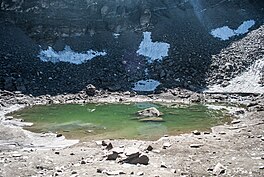| Roopkund | |
|---|---|
| |
 Lake in August 2014 | |
| Location | Chamoli, Uttarakhand |
| Coordinates | 30°15′44″N 79°43′54″E / 30.26222°N 79.73167°E |
| Average depth | 3 metres (9.8 ft) |
| Surface elevation | 4,536 metres (14,882 ft) |
 | |
Roopkund (locally known as Mystery Lake or Skeleton Lake)[1] is a high altitude glacial lake in the Uttarakhand state of India. It lies in the lap of Trishul massif. Located in the Himalayas, the area around the lake is uninhabited and is roughly at an altitude of 5,020 metres (16,470 ft),[1] surrounded by rock-strewn glaciers and snow-clad mountains. Roopkund is a popular trekking destination.[2] The size of the lake varies substantially, but it is seldom more than 40 metres in diameter (1000 to 1500 square metres in area), and is frozen in the winter.[3]
With a depth of about three metres, Roopkund is widely known for the hundreds of human skeletons found at the edge of the lake.[4] The human skeletal remains are visible at its bottom when the snow melts.[5] Initial investigations led some to believe they were the remains of a semi-legendary event when a single group was killed in a sudden and violent hailstorm in the 9th century,[6] but scientific research has subsequently shown that the remains belong to three distinct groups who died in two independent events; around 800 CE and 1800 CE respectively.[7] Because of the human remains, the lake has been called "Skeleton Lake" in recent times.[8]
- ^ a b Alam, Aniket (29 June 2004). "Fathoming the ancient remains of Roopkund". The Hindu. Archived from the original on 7 November 2004. Retrieved 29 May 2013.
- ^ Kohli, M.S. (2000). The Himalayas : playground of the gods : trekking, climbing, adventure. New Delhi: Indus Publishing Co. p. 79. ISBN 9788173871078.
- ^ Harney, Éadaoin; Nayak, Ayushi; Patterson, Nick; Joglekar, Pramod; Mushrif-Tripathy, Veena; Mallick, Swapan; Rohland, Nadin; Sedig, Jakob; Adamski, Nicole; Bernardos, Rebecca; Broomandkhoshbacht, Nasreen; Culleton, Brendan J.; Ferry, Matthew; Harper, Thomas K.; Michel, Megan; Oppenheimer, Jonas; Stewardson, Kristin; Zhang, Zhao; Bartwal, Maanwendra Singh; Kumar, Sachin; Diyundi, Subhash Chandra; Roberts, Patrick; Boivin, Nicole; Kennett, Douglas J.; Thangaraj, Kumarasamy; Reich, David; Rai, Niraj (20 August 2019). "Ancient DNA from the skeletons of Roopkund Lake reveals Mediterranean migrants in India". Nature Communications. 10 (1): 3670. doi:10.1038/s41467-019-11357-9. PMC 6702210. PMID 31431628.
- ^ Andrews, Robin George (20 August 2019). "The Mystery of the Himalayas' Skeleton Lake Just Got Weirder: Every summer, hundreds of ancient bones emerge from the ice. A new genetic study helps explain how they got there". The New York Times. Retrieved 14 October 2019.
- ^ Sati, Vishwambhar Prasad; Kumar, Kamlesh (2004). Uttaranchal: dilemma of plenties and scarcities (1st ed.). New Delhi: Mittal Publ. p. 82. ISBN 9788170998983.
- ^ "Skeleton Lake of Roopkund, India". Atlas Obscura. Retrieved 25 October 2016.
- ^ Cite error: The named reference
Ancient DNAwas invoked but never defined (see the help page). - ^ "Roopkund lake's skeleton mystery solved! Scientists reveal bones belong to 9th century people who died during heavy hailstorm". India Today. 31 May 2013. Retrieved 12 June 2013.

